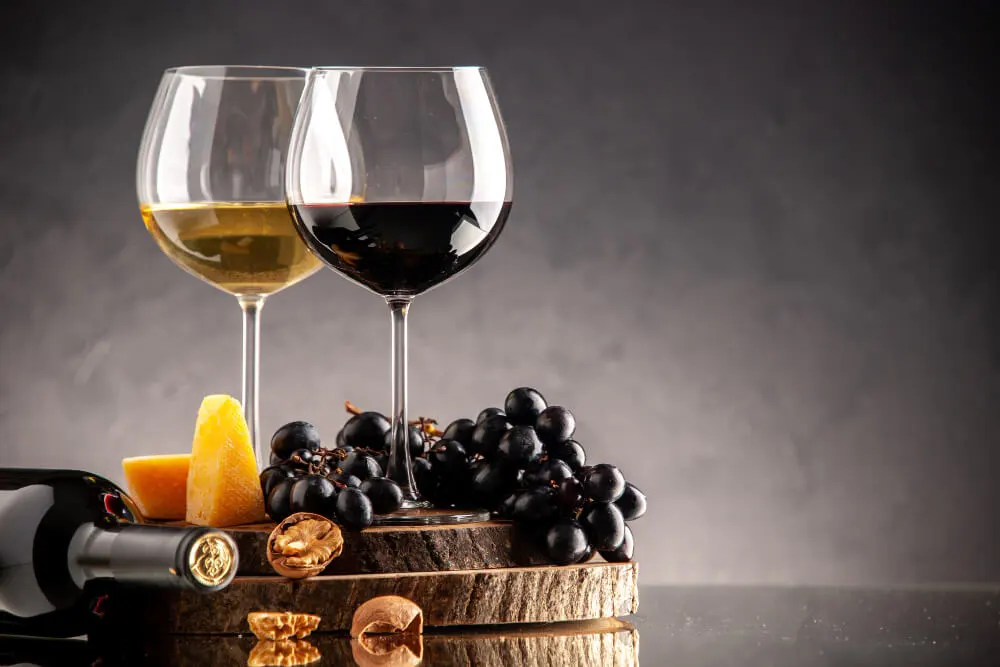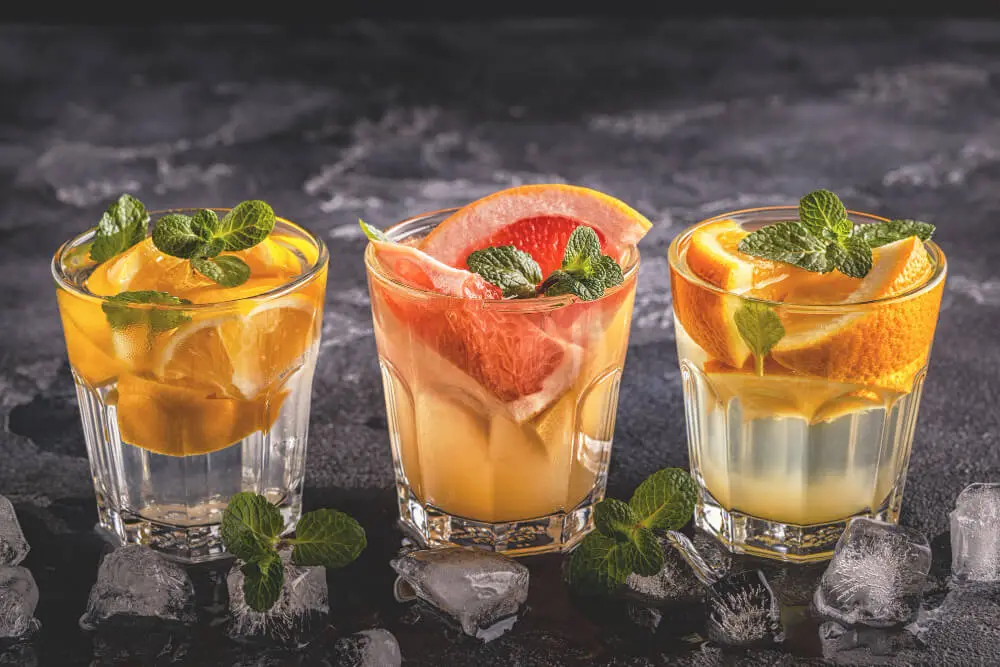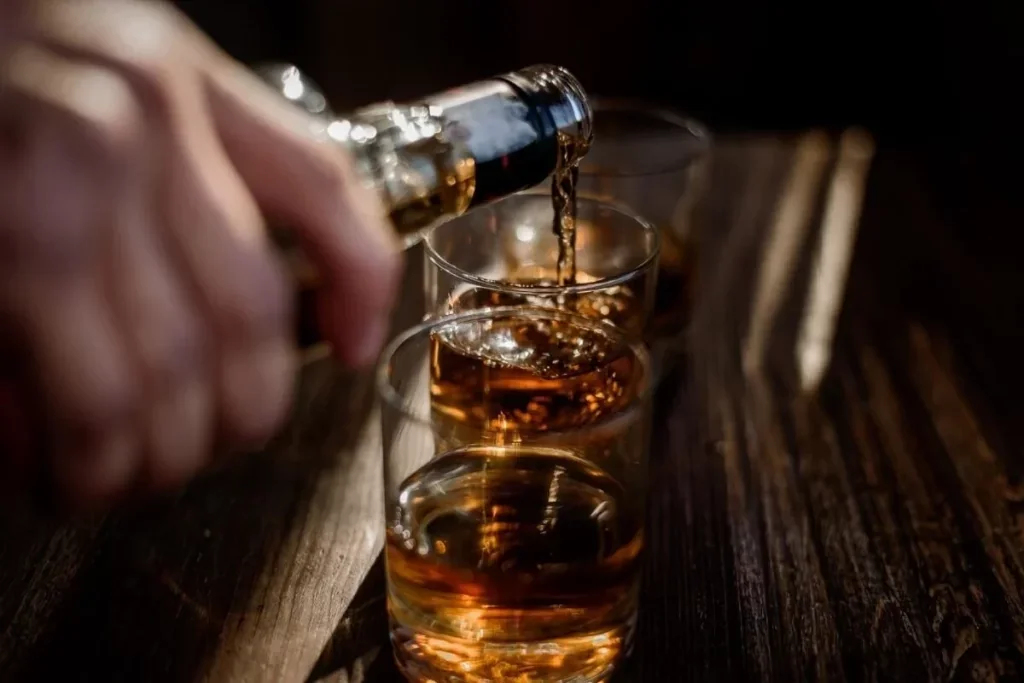Liquor is a beverage, especially an alcoholic drink, which contains ethanol (CH3CH2OH). It is also called “alcoholic liquor” or simply “alcohol.” Alcoholic beverages are divided into three classes: beers, wines, and spirits. The process of making own alcohol begins with fermentation. Most of the world’s beer and wine is produced from fermented cereal grains. These are processed into beer or wine, further distilling to make other alcoholic drinks like whiskey or rum.
How to make homemade alcohol?
Making alcohol at home is very simple; the ingredients necessary are yeast, common table sugar, and water. When you add these three, you can make your alcoholic drinks or beverage like beer and wine.
Let’s dive into the detailed process of making homemade alcohol at home:
Making alcohol with Homemade Wine
Homemade wine and beer are not only delicious but also healthy. You can control the quality of ingredients that go into it, and fermenting is a lot easier than distilling alcohol. Homemade wine and beer produce innocuous ethanol that does not contain any toxic compounds like methanol or acetone.
Homemade wine and beer may be distilled to make other alcohol used as denatured alcohol for fuel.
Precautions During the Process of Making own Alcohol at Home:
- Always use a non-reactive container (glass and stainless steel are safe). If you let metal react with your brew, it could make the flavor unpleasant and even poisonous.
- Do not inhale or ingest essential oils. Essential oils are the extracts from flowers, roots, and other aromatic parts of plants that provide a distinctive flavor to your brew. However, these oils can be potentially poisonous if taken internally.
- Keep the fermenter covered at all times, except when stirring or transferring liquid from one container into another. It will keep insects out of your brew.
- Keep the fermenter in a cool dark place where it will not be bothered by animals or humans for about two weeks.
- Do not use any of the brews before at least three weeks of fermentation.
- When trying out new recipes, take small experimental portions, then wait one week to gauge typical results for that recipe.
Homemade wine recipe:

- Crush fresh wine grapes and remove the pulp.
- Add a spoonful of yeast to a glass of warm water and mix well. Let it sit for at least five minutes before using.
- In a pot, put in one gallon of grape juice and six cups of table sugar. Mix slowly over low heat to dissolve granulated sugar.
- Meanwhile, dissolve the yeast mixture in a portion of the grape juice until creamy looking. Gradually pour this mixture into the pot while stirring continuously.
- Stir well and let it sit for an hour or two until it cools to a lukewarm temperature. Add more sugar if necessary, but be sure not to add too much, or your yeast will be killed.
- Pour the mixture into a fermenting container, then add two crushed Campden tablets to kill any bacteria or other harmful organisms that may have been present in the fruit juice.
- Add a packet of Lalvin K1V-1116 wine yeast and stir well. Close with an airlock to allow CO2 gasses to escape.
- Let the wine ferment for a week or until bubbling slows down considerably or stops completely.
- Siphon the liquid into a clean container and let it sit for three weeks without racking (fining).
- Rack at least once during this period.
- After siphoning, add 5 Campden tablets to kill any remaining yeast, then siphon into bottles and cork.
- Wine yeast is the perfect choice for new brewers.
- It ferments well between 60F to 80F temperatures, creating subtle flavors in relatively short periods without producing too many fusel alcohols, often associated with hangovers.
- Spirits sold commercially are generally distilled at higher proofs to eliminate the fusel alcohols.
- Fermented beverages that are allowed to ferment for a long period produce high-proof, full-bodied vodka and gin with much higher flavors than the original materials.
The ingredients of homemade wine and beer are simple, with basic knowledge of cooking. However, it would help if you did not try to make your brew unless you know the basics of homebrewing or making wine. Fermentation requires some knowledge about microbiology which is the study of microorganisms like yeasts and bacteria, essential for converting sugars into ethanol.
Homemade Distilled Spirits

In making homemade distilled spirits:
- Use ten pounds of sugar per gallon of water when preparing your wash to make ethanol.
- Use two ounces of fresh yeast or one package of yeast for every ten pounds sugar source.
- Ferment the wash until the yeast cells die off or fall to the bottom of your fermenter, which takes about two weeks.
- Then siphon your fermented liquid into a new container and let it settle overnight.
- The next day, use an aquarium pump to move the liquid into your still column.
- A still is a big kettle with attachments that separate liquids based on boiling points.
- To operate your still, first determine the alcohol percentage you intend to produce.
- A good place to start for beginners would be 60 percent ABV (120 proof).
- Then create a cooling tube that will reach your still bottom into or close to your collection bottles.
- The cooling tube should be at least 8 inches long and 1 inch thick.
- After the first few pints of distillate, you can experiment with percentages and tubing length to avoid losing any alcohol from your still.
- Distilling is dangerous work that requires a good understanding of chemistry.
- Please do not attempt to make your own distilled spirits unless you know what you are doing.
Homemade wine is fermented from grape juice or other fruit juices, not grain mash as in brewing beer. It makes it much easier to produce a few gallons for personal consumption without the need for a still. In most states homebrewing and making wine is illegal since alcoholic beverages contain about 5 percent ABV (10 proof).
However, most states allow people to produce small amounts of distilled spirits for personal consumption.
Homebrewing Beer and Wine Kits:
To make a basic wine or beer:
- Add 8 oz (1 cup) dextrose monohydrate to five gallons of water and bring to a boil.
- Once boiling, remove the pot from the heat and stir in your malt extract until dissolved.
- Return the pot to a boil, add hops according to schedule and let boil for 45 minutes. It adds flavor and helps preserve the brew for storage.
- After boiling, cool the pot as fast as possible to around 80F degrees and transfer it into a sanitized fermenter.
- If necessary, top up with water to achieve five gallons total volume, add yeast according to package instructions
- Let sit for two weeks before bottling. Let sit in bottles for two weeks and enjoy.
- If you want to make a more complex homemade brew, try using a malt extract syrup instead of dried malt extract added to hot water.
- It allows you to make five gallons and is easier than adding individual grains to the boil.
- Also, if you enjoy the taste of homebrew, try making your malt extract which is just concentrated wort.
Homemade Liqueur
There are two ways to make your liquor – by distilling or fermenting – both require a still. Use the same recipe as for homemade distilled spirits, but instead of siphoning into a new container, let it settle overnight and then siphon it directly into the still column.
How to make Homemade Liqueurs using fermentation process:
- Wash 10 pounds of fruit in hot water to kill bacteria. – Add 2 gallons of boiling water to the fruit and allow it to sit for 30 minutes.
- Drain out the liquid, add an equal amount of cool boiled water, cover loosely with a lid or cloth, let settle overnight.
- Pour off the clear liquid into a still column.
- Boil the remaining fruit mash for 30 minutes, occasionally stirring to prevent burning.
- Pour the boiled mash into a strainer and let cool overnight so dead yeast cells will settle out.
- Add an equal amount of cold water to the strained liquid.
- It is your fermented liquor base for making liqueurs, plant extracts, or vodkas.
- Place the fermented liquor base in a still column, add an equal amount of pure grain alcohol or vodka to it, and run through your still.
- Add flavor, essences, and colorings to taste just before bottling if desired.
Limoncello is a common liqueur made by infusing lemon zest in grain alcohol for two weeks.
Homemade Infused Liquor
An infusion is simply the actual process of adding herbs, spices, or fruit to liquor to give it flavor. It’s important to remove aromatics (flavorings) before distilling, or they could ruin your still.
For flavoring your liquors at home, you will need:
- Alcohol base – vodka, grain alcohol, or pure cane sugar alcohol. Commercial vodka, Everclear, or Bacardi 151 work well.
- Flavoring – herbs and spices that go into the recipe you choose.
- An infusion jar – a wide mouth jar with lid, canning jars work well.
- Wire strainer or mesh filter (optional).
- A funnel (optional) – If using a mesh filter, line the funnel with cheesecloth or fine muslin to hold back bits of fruit and spices.
- The liquor you wish to infuse (vodka is good for beginners).
- Sieve or colander, stirring spoon.
How to Make Infused Liquor at home?

Here are the steps to make infused liquor at home:
- Using the funnel, pour the infusion into the jar filling it three-fourths full.
- Put on the lid and shake thoroughly to mix flavors.
- Uncap jar and add the desired amount of alcohol base to top of the jar.
- If using a wire mesh strainer or cheesecloth, add dry ingredients and infuse for up to 30 days. If not, shake daily.
- Strain liquor through a sieve lined with 2 layers of cheesecloth into another jar.
- Bottle and cap tightly.
- Add the desired amount to drinks or pour undiluted over ice.
Liqueur Recipes:
- Cherry Liqueur: I use this recipe because it’s easy and tastes great than other cherry liqueurs you can buy at liquor stores.
Ingredients
- 1 ½ cups chopped maraschino cherries (bottled in juice), or 1 ½ cups drained canned tart red cherries.
- 3/4 cup citron flavored vodka.
- One tablespoon glycerin (optional).
- ½ teaspoon almond extract (optional).
Recipe
- Put water in a saucepan and bring to a boil.
- Place chopped fruit in a jar, then pour boiling water into the jar.
- Top with vodka, cap tightly, and let stand for one month.
- Strain through 2 layers of cheesecloth or muslin bag into another jar (if you want a clear liqueur) or directly into the final container (if you like the fruit chunks in the drink).
- Add glycerin and almond extract if desired, stir and cap tightly.
- Let stand for one month and occasionally shake (optional).
- Cinnamon Liquor: One gallon of vodka or grain alcohol 3 cups ground cinnamon sticks Mix in a clean, dry jar and shake daily for one month. Strain through a cheesecloth or fine-mesh strainer lined with a muslin bag into another clean, dry jar.
- Tequila Sunrise: Fill a glass 3/4 full with ice cubes. Pour 2 ounces of tequila into the glass. Gently add 4 to 6 ounces of orange juice or soda water; don’t mix it in completely. Garnish with a slice of orange and a cherry (optional).
- Vodka Martini: 5 ounces vodka, 1 ½ teaspoon dry vermouth, ice cubes. Shake or stir vodka and vermouth in a mixing glass with ice cubes. Strain into a cocktail glass and garnish with an olive or twist of lemon peel (optional).
- Coffee Liqueur: 3 cups water, 1 cup grated chocolate (preferably Dutch-processed), 1 cup strong black coffee, 1/2 cup sugar.
- Chocolate Liqueur: 3 cups water, 4 ounces unsweetened chocolate (grated or chopped), 2 1/2 cups sugar, one teaspoon vanilla essence, pinch salt.
- Kahlua: 3 cups water, 1 cup coffee beans, 1 cup sugar, 3/4 cup vodka.
- Apple Liqueur: 4 cups water, nine medium-sized apples (washed and cored), one teaspoon vanilla essence or extract, 2 1/2 cups sugar.
- Banana Liqueur: 4 cups weak black tea (brewed), 1 large ripe banana (peeled and mashed), 1/2 cup sugar, 1 teaspoon lemon juice, 2 cups vodka.
Frequently Asked Questions
How can I make alcohol at home fast?
You can’t make it fast because making alcohol at home requires patience and time for a few days. The easiest and cheapest way to get the ingredients is to buy Everclear, but if you can’t find it where you live, then you’ll have to start from scratch with sugar and yeast.
How long will the liqueur keep?
Liqueurs made with 190 proof alcohol should last long if kept away from heat or direct sunlight. If vodka is less strong (80 proof), the liqueur should last for at least 1 year.
Can I make a flavorless liqueur?
Yes. Use only one of the following ingredients: water, vodka, or grain alcohol.
How should I store my liqueur?
Keep your liqueurs in a cool dark place that is not too humid. Sunlight and heat will deteriorate the liqueur quickly if you can keep it in a refrigerator, even better. Better quality liqueurs will keep longer, but if you want to drink it right after your liqueur is ready, that’s ok.
Can I use another alcohol instead of vodka or Everclear?
– Yes, but be aware that the resulting liqueur may not be as strong (flavorful) as the one made with 190 proof alcohol. If using another type of alcohol, make sure the alcohol content is at least 40% (80 proof).
Can I use first or second-run filtered honey?
– Yes. You won’t need more than 1/2 cup, which means your total cost will be about $5 for a quart of Honeymoon Liqueur. The resulting liqueur may not be as strong (flavorful) as the one made with unprocessed honey.
Can I mix different kinds of honey?
Yes, this will give your liqueur an interesting character and complexity that you don’t get with only one type of honey.
Can I use other types of fruit?
Yes, but make sure the fruit has a mild flavor before adding it to your liqueur (the flavor will be stronger when the liqueur is done). You can also mix different fruits if you like.
Can homemade liqueur make me drunk?
No, homemade liqueur contains very little alcohol. One ounce of grain alcohol is the equivalent of drinking 1 1/2 ounces of 80 proof vodka or 5 ounces of wine.
Which alcohol is easier to make?
Mead is the easiest alcohol to make if you don’t mind the honey taste (some people love it, others hate it). It’s also easier to make fruit-flavored liqueurs. If you want neutral-tasting alcohol, go with vodka or grain alcohol.
Is homemade alcohol safe to drink?
Yes. The ingredients are not toxic or hazardous. The only potential risk is if you use moldy or rotten honey or fruit.
Conclusion
Making your alcohol at home is simple, fun, and very rewarding. There are many recipes available on the Internet, but I recommend you start with this simple recipe so you can taste your results quickly. You will be making your flavored liqueurs in no time once you see how easy it is to make these!
